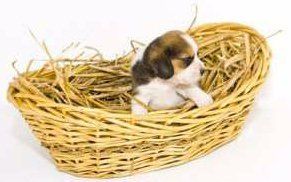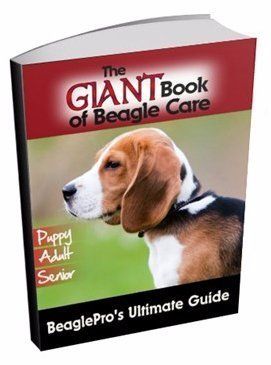Facts About Beagles

About Beagles
While most of us know that Snoopy is a Beagle, let's take a look at some real-life Beagle facts.
Whether you already have one of these amazing dogs, or you are thinking about bringing one into your home...You will want to learn about the Beagle breed.

Beagles were developed in England as hunting dogs to chase down small prey such as rabbits. A lot has changed since the origin
and perfection of the breed. Today, many people still use Beagle to hunt rabbit... but just as many keep this dog breed as a family companion pet.

Males are almost always larger than females.
This makes breeding a bit tricky, as the best pairing is a larger female and a smaller male dog.

While usually classified as a "low shedder" due to the very short coat...all dogs shed. It is a normal process for each hair follicle to fall out after it grows to a certain length and then is replaced by another.
However, it is true that some dogs shed much lighter than other. When it comes to knowing this about Beagles, this breed is a light shedder. There are times when the shed may be heavier. This will happen to a more moderate degree if the dog lives in an area that experiences extreme seasonal temperature changes.
Also, females may "blow the coat" after a heat cycle due to hormonal changes and many females lose some coat after giving birth.

All Beagles have white tipped tails, although it may not be apparent. Some have very few white hairs, only noticeable upon very close inspection, others (usually hunter Beagles) will have hair loss on the tip and there are some that have docked tails
although this goes against the AKC breed standard. However, this is a strong trait that has been bred into the Beagle bloodline.

While extremely friendly and an absolutely wonderful family pet, owners should be careful when a Beagle is around other small pets such as chinchillas, hamsters, mice, etc. The hunting instinct in this dog may take over and an owner may find that their dog "brings them a present".

One interesting thing about Beagles is that the breed variety of the "Pocket Beagle" is now extinct. Long ago, there was a dog with this name, however it referred to any small hunting type canine. The bloodlines no longer exist. In today's times, any puppy sold with this term is not and cannot be an actual pocket Beagle.

While stereotyped as howlers, this breed usually only barks when strangers approach or if they pick up what they consider to be an interesting scent. Those that have Separation Anxiety will also let out a howling bark. For each of these instances, training can greatly reduce the amount of barking.

Another false thought by many, is that this dog has a bad odor. This is not true. The average pet Beagle does not have any noticeable body odor. The one exception might be an un-spayed female during heat.
Another reason that this dog may have an unpleasant owner is if they roll around in mud or other smelly substances. And of course, dogs that are left to live outdoors usually have a bad smell.

This breed is very happy living in small apartments or large sprawling homes. However, an owner must keep in mind that when living in a smaller home, daily outdoor exercise such as going for a brisk walk, is important to do at least 1 time per day.

The Beagle is an indoor dog! Long ago, rabbit hunting Beagles either lived in kennels with many other dogs for warmth or slept by the fireplace in their master's home.
They did not need to live outdoors to acclimate to temperatures. While he may love exercising with you outside, you will want your dog to sleep and live in the home with you.

Sadly, the Beagle is used in research labs
more than any other dog breed. In an effort to receive consistent results and to streamline testing, one breed was chosen, and that was the Beagle. They are used to test everything from household products to pesticides to new drugs. Some testing is very painful and there are groups that work tirelessly to both push legislation to stop this and also to rescue dogs from labs.

While hunting Beagles may love to head out into the fields with their owner, this is not a "one man dog". Because of their instinct to be in a "pack", most enjoy being part of large human family very much.

This breed is remarkably good at sniffing out and detecting bed bugs - a tiny little pest that can invade homes. There are select Beagles that are put to work doing this and are referred to as Bed Bug Beagles.

You may be surprised, but most get along very well with cats. Because of the hunting instinct, you do need to make the proper introductions. Once doing so, a Beagle and a cat
can become be friends. Sometimes, this does take a bit of time. One way to know that a dog and cat are going to not fight, is if they ignore each other at first.
This means that neither finds the other to be a threat. Then, as time goes by, you will usually find that both canine and feline love to cuddle, play and be "siblings".
You may also be interested in:
Beagle is acting strange
- There's all sort of odd quirky behaviors that a dog can have; this article explains those most commonly seen.
Feeding a Beagle
- This active, lean dog can quickly become overweight without a proper diet.
Beagle Health Issues
- Every breed is prone to certain genetic conditions. Learn how to keep your dog healthy and what to keep an eye out for.
Beagle with Gas Problems
- There are several factors that can cause a Beagle to develop a moderate to severe gas issue. Learn about at-home treatments.
Beagle Care Tips
- The top 7 most important guidelines for optimal health, safety, and happiness.



